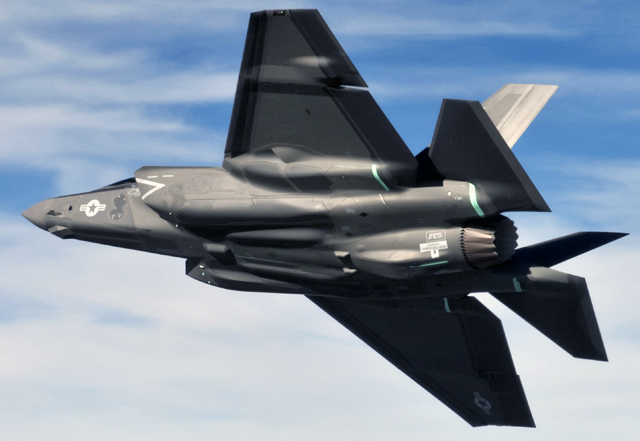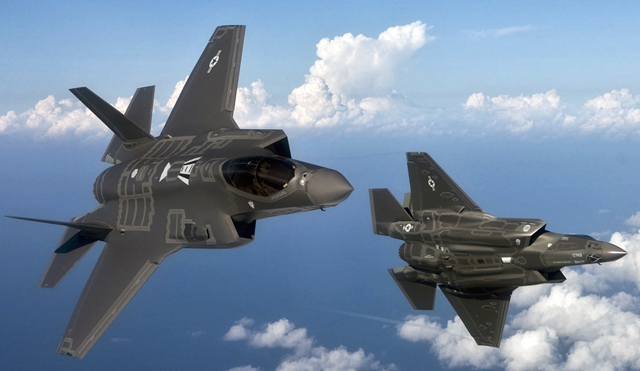The Pentagon's decision to reduce the performance specifications for the Lockheed Martin F-35 Joint Strike Fighter will have a significant operational impact, a number of highly experienced fighter pilots consulted by Flightglobal concur. But the careful development of tactics and disciplined employment of the jet may be able to mitigate some of those shortcomings.
"This is going to have a big tactical impact," one highly experienced officer says. "Anytime you have to lower performance standards, the capability of what the airframe can do goes down as well."
 |
|---|
Lockheed Martin |
The US Department of Defense's decision to relax the sustained turn performance of all three variants of the F-35 was revealed earlier this month in the Pentagon's Director of Operational Test and Evaluation 2012 report. Turn performance for the US Air Force's F-35A was reduced from 5.3 sustained g's to 4.6 sustained g's. The F-35B had its sustained g's cut from five to 4.5 g's, while the US Navy variant had its turn performance truncated from 5.1 to five sustained g's. Acceleration times from Mach 0.8 to Mach 1.2 were extended by eight seconds, 16 seconds and 43 seconds for the A, B and C-models respectively. The baseline standard used for the comparison was a clean Lockheed F-16 Block 50 with two wingtip Raytheon AIM-120 AMRAAMs. "What an embarrassment, and there will be obvious tactical implications. Having a maximum sustained turn performance of less than 5g is the equivalent of an [McDonnell Douglas] F-4 or an [Northrop] F-5," another highly experienced fighter pilot says. "[It's] certainly not anywhere near the performance of most fourth and fifth-generation aircraft."
At higher altitudes, the reduced performance will directly impact survivability against advanced Russian-designed "double-digit" surface-to-air missile (SAM) systems such as the Almaz-Antey S-300PMU2 (also called the SA-20 Gargoyle by the North Atlantic Treaty Organization), the pilot says. At lower altitudes, where fighters might operate in for the close air support or forward air control role, the reduced airframe performance will place pilots at increased risk against shorter-range SAMs and anti-aircraft artillery.
Most egregious is the F-35C-model's drastically reduced transonic acceleration capabilities. "That [43 seconds] is a massive amount of time, and assuming you are in afterburner for acceleration, it's going to cost you even more gas," the pilot says. "This will directly impact tactical execution, and not in a good way."
Pilots typically make the decision to trade a very high rate of fuel consumption for supersonic airspeeds for one of two reasons. "They are either getting ready to kill something or they are trying to defend against something [that's trying to kill] them," the pilot says. "Every second counts in both of those scenarios. The longer it takes, the more compressed the battle space gets. That is not a good thing."
 |
|---|
Lockheed Martin |
While there is no disputing that the reduced performance specifications are a negative development, there may be ways to make up for some of the F-35's less than stellar kinematic performance.
Pilots will have to make extensive use of the F-35's stealth characteristics and sensors to compensate for performance areas where the jet has weaknesses, sources familiar with the aircraft say. But engagement zones and maneuvering ranges will most likely be driven even further out against the most dangerous surface-to-air threats.
In an air-to-air engagement, for example, tactics would have to be developed to emphasize stealth and beyond visual range (BVR) combat. If a visual range engagement is unavoidable, every effort would have to be taken to enter the "merge" from a position of advantage, which should be possible, given the F-35's stealth characteristics.
Once engaged within visual range, given the F-35's limitations and relative strengths, turning should be minimized in favor of using the jet's Northrop Grumman AAQ-37 distributed aperture system of infrared cameras, helmet-mounted display and high off-boresight missiles to engage the enemy aircraft. If a turning fight is unavoidable, the F-35 has good instantaneous turn performance and good high angle of attack (50°AOA limit) performance comparable to a Boeing F/A-18 Hornet, which means a similar strategy could be adopted if one finds him or herself in such a situation.
 |
|---|
Lockheed Martin |
Lockheed, for its part, maintains that the F-35 has performance superior to that of any "legacy" fighter at high altitudes. "Having flown over 4000 hours in fighter jets, I will tell you the F-35's capability at altitude, mostly driven by the internal carriage of those weapons, as a combat airplane, this airplane exceeds the capabilities of just any legacy fighter that I'm familiar with in this kind of regime," says Steve O'Bryan, the company's business development director for the F-35 during a January interview.
But much of the discussion is theoretical at this point, the F-35 has not been operationally tested, nor have tactics been developed for the aircraft's usage. How the aircraft will eventually fare once fully developed and fielded is an open question.
Source: Flight International























